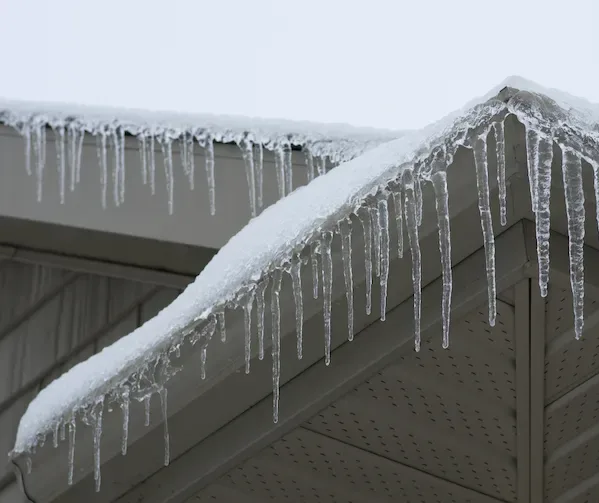New England’s transition from colorful fall to the first snowflakes arguably marks the most enchanting time of the year. However, with the changing seasons, winter concerns come to the forefront for us as an HVAC company. While your heating system shoulders most of the winter workload, ensuring its smooth operation requires some upkeep. In particular, your outdoor unit is subject to all the elements year-round. Such units are built to withstand winter but should stay top of mind when snow and ice begin to accumulate.
Observing ice on your HVAC condenser might raise concerns about potential issues. While icicles gathering along your roof may be picturesque, those on your HVAC unit demand consideration. Initially seeming harmless, these icy formations can compromise your system’s efficiency and pose threats to your home’s safety.
Why Icicles Form
Icicles grow when any form of water is frozen, including humidity. While small icicles may indicate frozen humidity expelled through the drainpipe during regular functioning, larger formations signal moisture collection from other sources, potentially indicating system irregularities or malfunctions.
Causes of Icicle Formation
- Nature
Snowstorms depositing snow on the condenser, exposed to the unit’s heat, may cause icicles.
- System Malfunction
Refrigerant leaks or system irregularities leading to moisture buildup can cause freezing and icicle formation, potentially indicating a system breakdown.

The Consequences of Icicles
Icicles pose risks to HVAC operation and your home’s well-being:
- Reduced Efficiency: Blocked vents or hindered airflow decrease system efficiency which could spike energy bills and strain equipment, potentially leading to breakdowns.
- Moisture Damage: As icicles thaw, there is potential for the fluid to refreeze which can lead to further complications. The expanding and contracting that occurs during freezing and thawing can break even the most seemingly sturdy components. Extra moisture around the unit can also pose a risk for mold growth.
Solutions
Regularly check for snow or ice buildup and gently remove it. Use a soft brush for delicate removal rather than an ice pick or shovel. If icicles persist or cannot be safely removed, seek guidance from an HVAC technician to address specific unit concerns.
Please keep in mind that this blog is intended to be a helpful supplement to professional advice. Please always consult a certified technician if you believe icicles on your unit need professional attention. We want you to stay warm and safe this winter!
If your question isn’t answered here, contact the Pierce Refrigeration team and one of our experts will guide you in finding your solution.
Need 24-7 emergency service? Looking for advice on improving your everyday air quality and comfort at home and work? Contact the friendly staff at Pierce Refrigeration at 800-696-1088 or info@piercerefrig.com.

